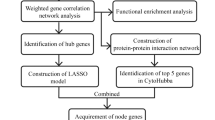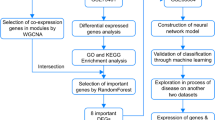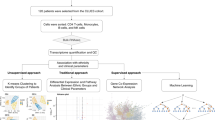Abstract
Behcet’s disease (BD) is a chronic inflammatory vasculitis and clinically heterogeneous disorder caused by immunocyte aberrations. Comprehensive research on gene expression patterns in BD illuminating its aetiology is lacking. E-MTAB-2713 downloaded from ArrayExpress was analysed to screen differentially expressed genes (DEGs) using limma. Random forest (RF) and neural network (NN) classification models composed of gene signatures were established using the E-MTAB-2713 training set and subsequently verified using GSE17114. Single sample gene set enrichment analysis was used to assess immunocyte infiltration. After identifying DEGs in E-MTAB-2713, pathogen-triggered, lymphocyte-mediated and angiogenesis- and glycosylation-related inflammatory pathways were discovered to be predominant in BD episodes. Gene signatures from the RF and NN diagnostic models, together with genes enriched in angiogenesis and glycosylation pathways, well discriminated the clinical subtypes of BD manifesting as mucocutaneous, ocular and large vein thrombosis involvement in GSE17114. Moreover, a distinctive immunocyte profile revealed T, NK and dendritic cell activation in BD compared to the findings in healthy controls. Our findings suggested that EPHX1, PKP2, EIF4B and HORMAD1 expression in CD14+ monocytes and CSTF3 and TCEANC2 expression in CD16+ neutrophils could serve as combined gene signatures for BD phenotype differentiation. Pathway genes comprising ATP2B4, MYOF and NRP1 for angiogenesis and GXYLT1, ENG, CD69, GAA, SIGLEC7, SIGLEC9 and SIGLEC16 for glycosylation also might be applicable diagnostic markers for subtype identification.





Similar content being viewed by others
Data availability
The dataset presented in this study can be found in ArrayExpress (https://www.ebi.ac.uk/arrayexpress/) and Gene Expression Omnibus (GEO) (http://www.ncbi.nlm.nih.gov/geo/) (GSE61399 and GSE17114).
Abbreviations
- AAV :
-
ANCA-associated vasculitis
- APC :
-
Antigen presenting cells
- AUC :
-
Area under the curve
- BD :
-
Behcet’s disease
- BP :
-
Biological process
- CCR :
-
Chemokine receptor
- CMV :
-
Cytomegalovirus
- C3 :
-
Complement 3
- DEG :
-
Differentially expressed gene
- FDR :
-
False discovery rate
- GEO :
-
Gene Expression Omnibus
- GO :
-
Gene Ontology
- GWAS :
-
Genome-wide association study
- HC :
-
Healthy control
- HSV :
-
Herpes simplex virus
- HLA :
-
Human leukocyte antigen
- IBD :
-
Inflammatory bowel disease
- iDC :
-
Immature dendritic cells
- IFN :
-
Interferon
- IL :
-
Interleukin
- KEGG :
-
Kyoto Encyclopedia of Genes and Genomes
- MB :
-
BD patients with mucocutaneous manifestations
- MG :
-
Module genes
- NK :
-
Natural killer cell
- NN :
-
Neural network
- OB :
-
BD patients with ocular involvement
- PCR :
-
Polymerase chain reaction
- pDC :
-
Plasmacytoid dendritic cell
- PG :
-
Paramount genes
- PPI :
-
Protein–protein Interaction
- pSS :
-
Primary Sjögren’s syndrome
- RA :
-
Rheumatoid arthritis
- RF :
-
Random forest
- ROC :
-
Receiver operating characteristic
- SLE :
-
Systemic lupus erythematosus
- ssGSEA :
-
Single sample gene set enrichment analysis
- Tfh :
-
Follicular helper T cell
- TNF :
-
Tumor necrosis-like factors
- Th :
-
Helper T cell
- Treg :
-
Regulatory T cell
- VB :
-
BD patients with large vein thrombosis
- WGCNA :
-
Weighted correlation network analysis
References
Yazici Y, Hatemi G, Bodaghi B, et al. Behçet syndrome. Nat Rev Dis Primers. 2021;7:67. https://doi.org/10.1038/s41572-021-00301-1.
Davatchi F, Chams-Davatchi C, Shams H, et al. Behcet's disease: epidemiology, clinical manifestations, and diagnosis. Expert Rev Clin Immunol. 2017;13:57–65. https://doi.org/10.1080/1744666x.2016.1205486.
Emmi G, Bettiol A, Silvestri E, et al. Vascular Behçet's syndrome: an update. Intern Emerg Med. 2019;14:645–52. https://doi.org/10.1007/s11739-018-1991-y.
Zhong Z, Su G, Zhou Q, et al. Tuberculosis Exposure With Risk of Behçet Disease Among Patients With Uveitis. JAMA Ophthalmol. 2021;139:415–22. https://doi.org/10.1001/jamaophthalmol.2020.6985.
Hatemi G, Yazici H. Behçet's syndrome and micro-organisms. Best Pract Res Clin Rheumatol. 2011;25:389–406. https://doi.org/10.1016/j.berh.2011.05.002.
Greco A, De Virgilio A, Ralli M, et al. Behçet's disease: New insights into pathophysiology, clinical features and treatment options. Autoimmun Rev. 2018;17:567–75. https://doi.org/10.1016/j.autrev.2017.12.006.
Su G, Zhong Z, Zhou Q, et al. Identification of Novel Risk Loci for Behçet's Disease-Related Uveitis in a Chinese Population in a Genome-Wide Association Study. Arthritis Rheumatol. 2022;74:671–81. https://doi.org/10.1002/art.41998.
Takeuchi M, Ombrello MJ, Kirino Y, et al. A single endoplasmic reticulum aminopeptidase-1 protein allotype is a strong risk factor for Behçet's disease in HLA-B*51 carriers. Ann Rheum Dis. 2016;75:2208–11. https://doi.org/10.1136/annrheumdis-2015-209059.
Gül A. Genetics of Behçet's disease: lessons learned from genomewide association studies. Curr Opin Rheumatol. 2014;26:56–63. https://doi.org/10.1097/bor.0000000000000003.
Afkari B, Babaloo Z, Dolati S, et al. Molecular analysis of interleukin-10 gene polymorphisms in patients with Behçet's disease. Immunol Lett. 2018;194:56–61. https://doi.org/10.1016/j.imlet.2017.12.008.
Hou S, Yang Z, Du L, et al. Identification of a susceptibility locus in STAT4 for Behçet's disease in Han Chinese in a genome-wide association study. Arthritis Rheum. 2012;64:4104–13. https://doi.org/10.1002/art.37708.
Xavier JM, Shahram F, Sousa I, et al. FUT2: filling the gap between genes and environment in Behçet's disease? Ann Rheum Dis. 2015;74:618–24. https://doi.org/10.1136/annrheumdis-2013-204475.
Carvalho BS, Irizarry RA. A framework for oligonucleotide microarray preprocessing. Bioinformatics. 2010;26:2363–7. https://doi.org/10.1093/bioinformatics/btq431.
Bolstad BM, Irizarry RA, Astrand M, et al. A comparison of normalization methods for high density oligonucleotide array data based on variance and bias. Bioinformatics. 2003;19:185–93. https://doi.org/10.1093/bioinformatics/19.2.185.
Kauffmann A, Gentleman R, Huber W. arrayQualityMetrics--a bioconductor package for quality assessment of microarray data. Bioinformatics. 2009;25:415–6. https://doi.org/10.1093/bioinformatics/btn647.
Oğuz AK, Yılmaz ST, Oygür Ç, et al. Behçet's: A Disease or a Syndrome? Answer from an Expression Profiling Study. PLoS One. 2016;11:e0149052. https://doi.org/10.1371/journal.pone.0149052.
Xavier JM, Krug T, Davatchi F, et al. Gene expression profiling and association studies implicate the neuregulin signaling pathway in Behçet's disease susceptibility. J Mol Med (Berl). 2013;91:1013–23. https://doi.org/10.1007/s00109-013-1022-4.
Diboun I, Wernisch L, Orengo CA, et al. Microarray analysis after RNA amplification can detect pronounced differences in gene expression using limma. BMC Genomics. 2006;7:252. https://doi.org/10.1186/1471-2164-7-252.
Yu G, Wang LG, Han Y, et al. clusterProfiler: an R package for comparing biological themes among gene clusters. Omics. 2012;16:284–7. https://doi.org/10.1089/omi.2011.0118.
Qing X, Xu W, Liu S, et al. Molecular Characteristics, Clinical Significance, and Cancer Immune Interactions of Angiogenesis-Associated Genes in Gastric Cancer. Front Immunol. 2022;13:843077. https://doi.org/10.3389/fimmu.2022.843077.
Mohamed Abd-El-Halim Y, El Kaoutari A, Silvy F, et al. A glycosyltransferase gene signature to detect pancreatic ductal adenocarcinoma patients with poor prognosis. EBioMedicine. 2021;71:103541. https://doi.org/10.1016/j.ebiom.2021.103541.
Langfelder P, Horvath S. WGCNA: an R package for weighted correlation network analysis. BMC Bioinformatics. 2008;9:559. https://doi.org/10.1186/1471-2105-9-559.
Szklarczyk D, Franceschini A, Wyder S, et al. STRING v10: protein-protein interaction networks, integrated over the tree of life. Nucleic Acids Res. 2015;43:D447–52. https://doi.org/10.1093/nar/gku1003.
Bader GD, Hogue CW. An automated method for finding molecular complexes in large protein interaction networks. BMC Bioinformatics. 2003;4:2. https://doi.org/10.1186/1471-2105-4-2.
Díaz-Uriarte R, Alvarez de Andrés S. Gene selection and classification of microarray data using random forest. BMC Bioinformatics. 2006;7:3. https://doi.org/10.1186/1471-2105-7-3.
Günther F, Fritsch S. neuralnet: Training of Neural Networks. R J. 2010;2(1):30–38. https://doi.org/10.32614/RJ-2010-006.
She J, Su D, Diao R, et al. A Joint Model of Random Forest and Artificial Neural Network for the Diagnosis of Endometriosis. Front Genet. 2022;13:848116. https://doi.org/10.3389/fgene.2022.848116.
Robin X, Turck N, Hainard A, et al. pROC: an open-source package for R and S+ to analyze and compare ROC curves. BMC Bioinformatics. 2011;12:77. https://doi.org/10.1186/1471-2105-12-77.
Barbie DA, Tamayo P, Boehm JS, et al. Systematic RNA interference reveals that oncogenic KRAS-driven cancers require TBK1. Nature. 2009;462:108–12. https://doi.org/10.1038/nature08460.
Charoentong P, Finotello F, Angelova M, et al. Pan-cancer Immunogenomic Analyses Reveal Genotype-Immunophenotype Relationships and Predictors of Response to Checkpoint Blockade. Cell Rep. 2017;18:248–62. https://doi.org/10.1016/j.celrep.2016.12.019.
Walker SE, Zhou F, Mitchell SF, et al. Yeast eIF4B binds to the head of the 40S ribosomal subunit and promotes mRNA recruitment through its N-terminal and internal repeat domains. Rna. 2013;19:191–207. https://doi.org/10.1261/rna.035881.112.
Chen B, Chen Y, Rai KR, et al. Deficiency of eIF4B Increases Mouse Mortality and Impairs Antiviral Immunity. Front Immunol. 2021;12:723885. https://doi.org/10.3389/fimmu.2021.723885.
Hua L, Yao S, Pham D, et al. Cytokine-dependent induction of CD4+ T cells with cytotoxic potential during influenza virus infection. J Virol. 2013;87:11884–93. https://doi.org/10.1128/jvi.01461-13.
Liu K, Wang Y, Zhu Q, et al. Aberrantly expressed HORMAD1 disrupts nuclear localization of MCM8-MCM9 complex and compromises DNA mismatch repair in cancer cells. Cell Death Dis. 2020;11:519. https://doi.org/10.1038/s41419-020-2736-1.
Eghbalpour F, Aghaei M, Ebrahimi M, et al. Effect of indole-3-carbinol on transcriptional profiling of wound-healing genes in macrophages of systemic lupus erythematosus patients: an RNA sequencing assay. Lupus. 2020;29:954–63. https://doi.org/10.1177/0961203320929746.
Li M, Qi Y, Wang G, et al. Proteomic profiling of saliva reveals association of complement system with primary Sjögren's syndrome. Immun Inflamm Dis. 2021;9:1724–39. https://doi.org/10.1002/iid3.529.
Cao Y, Mi X, Wang Z, et al. Bioinformatic analysis reveals that the OAS family may play an important role in lupus nephritis. J Natl Med Assoc. 2020;112:567–77. https://doi.org/10.1016/j.jnma.2020.05.006.
He P, Zhang Z, Liao W, et al. Screening of gene signatures for rheumatoid arthritis and osteoarthritis based on bioinformatics analysis. Mol Med Rep. 2016;14:1587–93. https://doi.org/10.3892/mmr.2016.5423.
Imgenberg-Kreuz J, Sandling JK, Almlöf JC, et al. Genome-wide DNA methylation analysis in multiple tissues in primary Sjögren's syndrome reveals regulatory effects at interferon-induced genes. Ann Rheum Dis. 2016;75:2029–36. https://doi.org/10.1136/annrheumdis-2015-208659.
Teruel M, Alarcón-Riquelme ME. The genetic basis of systemic lupus erythematosus: What are the risk factors and what have we learned. J Autoimmun. 2016;74:161–75. https://doi.org/10.1016/j.jaut.2016.08.001.
Imgenberg-Kreuz J, Carlsson Almlöf J, Leonard D, et al. DNA methylation mapping identifies gene regulatory effects in patients with systemic lupus erythematosus. Ann Rheum Dis. 2018;77:736–43. https://doi.org/10.1136/annrheumdis-2017-212379.
Haque M, Singh AK, Ouseph MM, et al. Regulation of Synovial Inflammation and Tissue Destruction by Guanylate Binding Protein 5 in Synovial Fibroblasts From Patients With Rheumatoid Arthritis and Rats With Adjuvant-Induced Arthritis. Arthritis Rheumatol. 2021;73:943–54. https://doi.org/10.1002/art.41611.
Gallucci S, Meka S, Gamero AM. Abnormalities of the type I interferon signaling pathway in lupus autoimmunity. Cytokine. 2021;146:155633. https://doi.org/10.1016/j.cyto.2021.155633.
Juczynska K, Wozniacka A, Waszczykowska E, et al. Expression of JAK3, STAT2, STAT4, and STAT6 in pemphigus vulgaris. Immunol Res. 2020;68:97–103. https://doi.org/10.1007/s12026-020-09122-y.
Yang X, Xiang Z, Sun Z, et al. Host MOV10 is induced to restrict herpes simplex virus 1 lytic infection by promoting type I interferon response. PLoS Pathog. 2022;18:e1010301. https://doi.org/10.1371/journal.ppat.1010301.
Al-Nashmi M, Taha S, Alsharoqi I, et al. Interleukin 1 receptor antagonist and 2'-5'-oligoadenylate synthetase-like molecules as novel biomarkers for multiple sclerosis patients in Bahrain. Mult Scler Relat Disord. 2017;18:1–7. https://doi.org/10.1016/j.msard.2017.09.001.
Beecham GW, Dickson DW, Scott WK, et al. PARK10 is a major locus for sporadic neuropathologically confirmed Parkinson disease. Neurology. 2015;84:972–80. https://doi.org/10.1212/wnl.0000000000001332.
González-Amaro R, Cortés JR, Sánchez-Madrid F, et al. Is CD69 an effective brake to control inflammatory diseases? Trends Mol Med. 2013;19:625–32. https://doi.org/10.1016/j.molmed.2013.07.006.
Hamzaoui K, Bouali E, Ghorbel I, et al. Expression of Th-17 and RORγt mRNA in Behçet's Disease. Med Sci Monit. 2011;17:Cr227–34. https://doi.org/10.12659/msm.881720.
Kim J, Park JA, Lee EY, et al. Imbalance of Th17 to Th1 cells in Behçet's disease. Clin Exp Rheumatol. 2010;28:S16–9.
Geri G, Terrier B, Rosenzwajg M, et al. Critical role of IL-21 in modulating TH17 and regulatory T cells in Behçet disease. J Allergy Clin Immunol. 2011;128:655–64. https://doi.org/10.1016/j.jaci.2011.05.029.
Ahmadi M, Yousefi M, Abbaspour-Aghdam S, et al. Disturbed Th17/Treg balance, cytokines, and miRNAs in peripheral blood of patients with Behcet's disease. J Cell Physiol. 2019;234:3985–94. https://doi.org/10.1002/jcp.27207.
Choi JY, Ho JH, Pasoto SG, et al. Circulating follicular helper-like T cells in systemic lupus erythematosus: association with disease activity. Arthritis Rheumatol. 2015;67:988–99. https://doi.org/10.1002/art.39020.
Cosan F, Aktas Cetin E, Akdeniz N, et al. Natural Killer Cell Subsets and Their Functional Activity in Behçet's Disease. Immunol Invest. 2017;46:419–32. https://doi.org/10.1080/08820139.2017.1288240.
Bonacini M, Soriano A, Zerbini A, et al. Higher Frequencies of Lymphocytes Expressing the Natural Killer Group 2D Receptor in Patients With Behçet Disease. Front Immunol. 2018;9:2157. https://doi.org/10.3389/fimmu.2018.02157.
Reizis B. Plasmacytoid Dendritic Cells: Development, Regulation, and Function. Immunity. 2019;50:37–50. https://doi.org/10.1016/j.immuni.2018.12.027.
Yilmaz S, Cinar M, Pekel A, et al. The expression of transmembrane and soluble CXCL16 and the relation with interferon-alpha secretion in patients with Behçet's disease. Clin Exp Rheumatol. 2013;31:84–7.
Sari I, Birlik M, Gonen C, et al. Cytomegalovirus colitis in a patient with Behcet's disease receiving tumor necrosis factor alpha inhibitory treatment. World J Gastroenterol. 2008;14:2912–4. https://doi.org/10.3748/wjg.14.2912.
Carmeliet P. Angiogenesis in health and disease. Nat Med. 2003;9:653–60. https://doi.org/10.1038/nm0603-653.
Acknowledgements
The authors would like to express special gratitude to the researchers of the datasets of E-MTAB-2713, GSE17114 and GSE61399.
Funding
This research was supported by grants from the National Key Research and Development Program of China (2018YFE0207300), Beijing Municipal Natural Science Foundation Project (7234383) and the National Natural Science Foundation of China Grants (81871302).
Author information
Authors and Affiliations
Contributions
Professor YZL conceived and designed the research. PhD. HTZ extracted the data, performed the software analysis and visualized the graphs and tables. PhD. LLC and HLL supervised the statistical analyses. PhD. HTZ, YML, HLL, YH, XML and SXY categorised the graphs and tables. PhD. HTZ wrote the paper. All authors are accountable for all aspects of the study and attest to the accuracy and integrity of the results. The authors have read and approved the final manuscript as submitted.
Corresponding author
Ethics declarations
Conflict of interest
The authors declare no competing interests.
Additional information
Publisher’s note
Springer Nature remains neutral with regard to jurisdictional claims in published maps and institutional affiliations.
Rights and permissions
Springer Nature or its licensor (e.g. a society or other partner) holds exclusive rights to this article under a publishing agreement with the author(s) or other rightsholder(s); author self-archiving of the accepted manuscript version of this article is solely governed by the terms of such publishing agreement and applicable law.
About this article
Cite this article
Zhan, H., Cheng, L., Li, H. et al. Integrated analyses delineate distinctive immunological pathways and diagnostic signatures for Behcet’s disease by leveraging gene microarray data. Immunol Res 71, 860–872 (2023). https://doi.org/10.1007/s12026-023-09398-w
Received:
Accepted:
Published:
Issue Date:
DOI: https://doi.org/10.1007/s12026-023-09398-w




